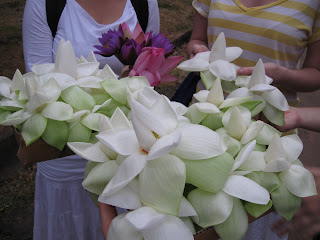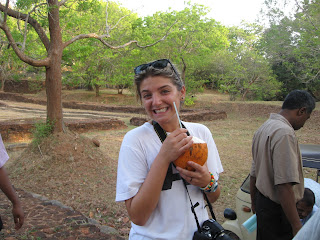It’s finally starting to feel normal to be here. Since returning from the Northern Tour, I haven’t left Kandy, and I’m starting to settle into a routine and learn my way around. As part of my attempt to get to know the city, I’ve been trying to walk as much as possible, instead of relying on tuktuks. I’ve managed to walk home from the ISLE Center and between the ISLE Center and the university by myself and plan on spending some time in Kandy Town soon. I’m also trying to figure out the bus system, which is not easy. The bus barely stops at the bus halts, which means you can’t hesitate when getting on or off, and the doors never close, so to eliminate the risk of falling out, you have to make sure you get pretty far in. I’m also never sure exactly how much it costs to get from one place to another, so I just give the money collector loose change until he looks satisfied and hope I’m not getting ripped off (so far, I haven’t had to pay more than about 15 cents for a ride).
At home, I think I’ve finally figured out who everyone is. In my house, it’s me and my amma and appaccii, who rent out the downstairs to a family with two little boys (ages 7 and 5, I think). In the house in front of mine, live my amma’s mother (my attamma), my amma’s sister, my amma’s older brother, his wife, my amma’s younger brother, his wife (although I think they might just be visiting because I thought my amma said that she only has two brothers and one lives in London), and their 21-year-old daughter, who’s a student at the University of Peradeniya. In the house next to mine, is the son of my amma’s older brother, his wife, and their children (two daughters, Supuni who will be 13 on Monday and Yasasvi who is 4, and one son, Yasas who just turned 7), and they rent out the downstairs of their house to a family with a 4-year-old boy.
However, where someone actually lives isn’t of much consequence during day light hours. At any given time, anyone could be in any of these houses, chatting, cooking, watching TV, or eating, although the main hang out is my attamma’s house, where I spend a lot of time on the porch. My amma’s older brother really likes to ask me about the United States and warn me about Sri Lankan mosquitoes but can be very hard to understand sometimes. A lot of the women also like to talk to/about me.
If I’m not on the porch, I’m usually with the children, who all call me Emma Akki (big sister). Supuni generally doesn’t play with the younger children, so I spend a lot of time talking to her. Even though she’s fluent in English (pretty much everyone is), she’s always willing to speak in Sinhala with me. I still need people to talk slowly, repeat themselves often, and define words I don’t know, but my Sinhala is definitely improving. I can usually understand the basic idea of what’s going on around me and even participate in simple conversations.
With the younger children, playtime is usually very active and consists of some combination of running, biking, and tree-climbing. They’ve tried to teach me some of their games (including cricket) but tend to lose interest before I’ve figured out the rules. For less strenuous activities, we watch TV and play Carrom, which they’re all considerably better at than I am.
Session II started on Monday, which means that now, in addition to Sinhala, I’m taking Tropical Economic Botany and Colonial History of Sri Lanka. We also get to take Kandyan Dance/Drumming and Batik classes, which I’m really enjoying. Botany seems like it’s going to be a lot of fun, and we’re in the field for one of our two classes every week—today we took a walk through the Peradeniya Botanical Gardens. History should also be interesting. Like most classes I’ve taken in college, we’re expected to read at home and then in class, we talk about colonial history. The only catch is, there’s no syllabus. The professor says he doesn’t want to burden us with a reading list. When we asked for some recommendations, he said he couldn’t remember any titles, but there are lots of books in the library. He demands questions of us after every other sentence he says, so we need some background in the colonial history of Sri Lanka, so hopefully I can find some good books. As for tests and papers, he said, “There will be an assignment,” but that there is no reason to talk about it now.
After school, I spend time with my family and do homework (after I have my tea, of course). My little brother put it very well when I came home today, by saying, “You should go up to your house. You put your bag down. You drink tea. You come down to play,” which is exactly what I did. It’s dark by 6:30, so everyone is in their respective houses by that time. In my house, Amma cooks dinner and cleans the kitchen, Appaccii watches TV, and I move around, sometimes doing homework, sometimes helping Amma, and sometimes watching TV with Appaccii. This wouldn’t be my first choice of activities, but it’s the only way I can spend time with Appaccii. He pretty much watches from the moment he gets home until he goes to bed at 8:30 with a short break for dinner, which we don’t eat together (I eat first, then Appacci, then Amma). Amma sometimes tries to get him to help her with something, but he usually manages to sneak away and get back to the TV. Amma also watches a fair amount of TV. She has her two teledramas (one at 8:30 and one at 9:00) that she watches every night after she cleans the kitchen and Appaccii goes to bed. Talking to other ISLE students, it sounds like such teledramas are popular in every Sri Lankan household—some students say that their families eat dinner while watching. I guess it’s how people entertain themselves, since no one goes outside after dark.
This weekend, it’s off to Nuwara Eliya to see the tea plantations and and Horton Plains National Park, including a hike to World’s End. Everyone says it’s incredibly beautiful there…I’ll try to get pictures up early next week.
























